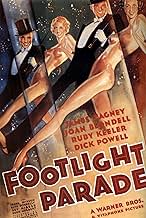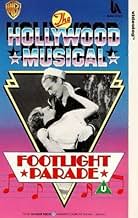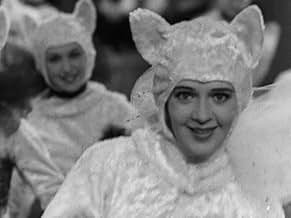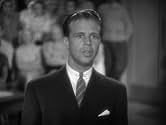Chester Kent struggles against time, romance, and a rival's spy to produce spectacular live "prologues" for movie houses.Chester Kent struggles against time, romance, and a rival's spy to produce spectacular live "prologues" for movie houses.Chester Kent struggles against time, romance, and a rival's spy to produce spectacular live "prologues" for movie houses.
- Awards
- 3 wins total
- Chorus Girl
- (uncredited)
- Chorus Girl
- (uncredited)
Featured reviews
First-rate Busby Berkeley musical from Warner Bros. with a terrific cast and the wonderful choreography Berkeley was known for. Most of the musical numbers are saved for the last half-hour but they're all great. James Cagney and Joan Blondell are lots of fun. They always had perfect chemistry. There's also a lot of snappy pre-Code lines, particularly from Blondell. Dick Powell and Ruby Keeler are also enjoyable. Nice support from solid character actors Frank McHugh, Guy Kibbee, Arthur Hohl, and Hugh Herbert. Fast-paced and highly entertaining. Essential for fans of Berkeley or the great leads.
Busby, of course, is the undisputed master of the Hollywood musical with "Gold Diggers of 1933" and "42nd Street" to his credit (as Dance Director). Footlight Parade is graced by hundreds of scantily-clad chorus girls, a Berkeley trademark. The elaborate dance numbers were shot with only one camera and Busby was the first director to film close-ups of the dancers. His obsession with shapely legs and "rear-view" shots is amply demonstrated here. The overall effect is highly erotic and mesmerizing.
Our boy Jimmy Cagney plays Chester Kent, a producer of "prologues" or short musical stage productions that were performed in movie theaters to entertain the audience before the talkies were shown. He's surrounded by crooked partners, a corporate spy, and a gold-digging girlfriend. Although Cagney had a solid background in vaudeville, this was the first film in which he showed his dancing talents. Joan Blondell is memorable as Cagney's wise-cracking, lovestruck secretary. And Ruby Keeler is adorable, as always.
The film climaxes with three outstanding production numbers, "Honeymoon Hotel", "The Waterfall", and "Shanghai Lil", each one a masterpiece and not likely to be duplicated in today's Hollywood where so-called "special effects" have replaced creative cinematography.
Claudia's Bottom Line: Clever and erotic, with some of the best musical production numbers ever put on celluloid. A thoroughly enjoyable Depression era romp.
The first half of "Footlight Parade" is preparation for a musical extravaganza which occupies the last half of the film. Chester Kent (Cagney) is about to lose his job and does lose his playgirl wife as a result of talking pictures squeezing out live stage musicals. His producers take him to see a popular talky of the day, John Wayne in "The Big Trail." Before each showing of the flick, a dance number is presented as a prologue. Shorts, news reels, serials, and cartoons would later serve the purpose. Kent gets the idea that a prologue chain would be the road to salvation for the dwindling live musical business. Kent is basically an idea man along the lines of choreographer Busby Berkeley. Could it be that Cagney's character is patterned after Berkeley? Could be.
In preparation for the prologues, Kent learns that his ideas are being stolen by a rival. He uncovers the traitor, fires him, then unbeknown to him a new leak is planted in the form a dazzling temptress. His assistant, Nan Prescott (Joan Blondell - soon to be Mrs. Dick Powell) has the hots for Kent and is determined to expose the wiles of the temptress. A new singer from Arkansas College shows up in the form of Scotty Blain (Dick Powell) who turns out to be a real find and is paired with Bea Thorn (Ruby Keeler). The resulting three prologue musicals, which couldn't possibly have been presented on any cinema stage of the day, are as fresh and enjoyable today as they were over seventy years ago, "Honeymoon Hotel," "By a Waterfall," and "Shanghai Lil."
Of special note is the song and dance of tough-guy James Cagney. Like Fred Astaire and Bill "Bojangles" Robinson, Cagney's dancing appeared natural and unrehearsed, although hours went into practice to get each step just right. Not as good a singer as Astaire, Cagney's singing, like Astaire's, sounded natural, unlike the crooning so popular at the time. It's amazing that one person could be so talented and so versatile as James Cagney.
Most critics prefer the "Shanghai Lil" segment over the other two. Yet the kaleidoscopic choreography of "By a Waterfall" is astonishing. How Berkeley was able to film the underwater ballets and to create the human snake chain must have been difficult because it has never been repeated. The close up shots mixed brilliantly with distant angles is a must-see. The crisp black and white photography is much more artistic than it would have been if shot in color.
Though not nearly as socially conscious as "Gold Diggers of 1933," "Footlight Parade" stands on its own as one of the most amazing and outrageous musicals ever put on the big screen.
Once more we have a film about a filmmaker fighting to stage a vision, here a preshow as opening act for the first talkies. He's a grunt, always storming in and out of rooms, yelling directions, now and then pausing to show the steps to the troupe or scream at a phone; but always fretting about new ideas to stage. He's played by James Cagney, whom we know best from tough-as-nails gangster roles. It's very apt casting. Cagney had many expressive talents, and a violent energy with the intuitive power to carry these into a performance.
But none of the ideas he comes up for the show seem like they've been very well thought out, they're all unfinished premises rushed with one foot out the door, so it's all a mystery how this strong-willed hack can give coherent shape to creative chaos. What kind of show he'll be able to put together. Money is staked on him, fortunes.
He's surrounded by three women, one for each number he's called to improvise. One is an ex-wife out for leeching money, another is his loyal secretary secretly in love. All three are fighting to seduce or be seduced, money is at stake again, and the art made with them.
It's all very enjoyable thus far, the rapid-fire banter and atmosphere of festive uproar. But it's not that it truly soars until we actually get to see on the stage how the various tribulations, that from our end so far seemed random and meaningless, were in fact shaping the vision that we get to see.
We drive back and forth around town to see these; the first number is about newly weds in the 'Honeymoon Hotel' with marriage slyly perverted as illicit sex that ends with bedroom eyes and mock happiness which we know will not last, and didn't for him, the other is a scene from everyday life on the street transformed on stage into the most gaudy spectacle with wood nymphs frolicking beneath cascading waters.
The third is the most stunning, because it substitutes for the internal processes that yield one happy end within another, both on the same stage. We knew our man was the author of these visions, the dreamer as it were, but was content so far to pull the strings from behind. Here an accident of fate forces him to get up on that stage and act out the part he was intuitively drawn to create: the number is about this man seeking out the woman of his dreams in a sort of smoky, semi-conscious stupor, and again the unforeseen circumstances - in this case, war - that keep love from them. Eventually he tricks both fates and us, the camera, to fulfill the dream.
So the happy end meant to take place in reality is pure Hollywood fiction, while the pure Hollywood fiction of the song and dance number reveals from machinations inside the soul a true purpose outside.
It is excellent stuff about the makings of images choreographed from the heart. Their power to articulate is this; art that reflects, salvages purpose from a life that appears incoherent, yet also reveals capricious fates of our own making that we have set in motion by simply living our part. Clearly this grunt could not have staged what he did, even with expert craft, if life around him had not seduced inspiration out of him.
The realistic, satirical treatment gives a fresh edge to the material and its pace and line delivery are breathtaking. To think that they only started making feature talking pictures 7 years before this! The brilliance of the dialogue cannot be matched anywhere today, especially considering that "realism" has taken over and engulfed contemporary cinema.
This film was made at a time when the Hayes code restricting content was being ignored and the result is a fresh, self-referential, critical and living cinema that spoke directly to contemporary audiences suffering through the depression and the general angst of the age. I'd recommend watching any film from this period, that is 1930-1935, for a vision of what popular cinema can potentially be.
Did you know
- TriviaFirst film where James Cagney dances - showing off his vaudeville and stage experience as a song-and-dance man. Cagney lobbied Warner Bros. to play this role. He would show off these talents to their fullest in La Glorieuse Parade (1942).
- GoofsAfter the "By A Waterfall" prologue ends, the film cuts to the audience giving an animated and thunderous applause, but in the balcony there is no applause or reaction. In fact, there is no movement whatsoever. They are perfectly still which indicates that a photo or painting was used for the balcony audience and then merged with the live theatre audience. The same photo/painting was also used for the "Shanghai Lil" balcony audience.
- Quotes
Nan Prescott: You scram, before I wrap a chair around your neck!
Vivian Rich: [Angrily] It's three o'clock in the morning - where do you want me to go?
[Nan starts to speak, but Vivian immediately cuts her off]
Vivian Rich: You cheap stenographer...
Nan Prescott: Outside, countess. As long as they've got sidewalks YOU'VE got a job.
[Shoves her out, gives her a swift kick in the rump, and slams the door behind her]
- Alternate versionsThere is an Italian edition of this film on DVD, distributed by DNA srl, "VIVA LE DONNE! (1933) + AMORE IN OTTO LEZIONI (1936)" (2 Films on a single DVD), re-edited with the contribution of film historian Riccardo Cusin. This version is also available for streaming on some platforms.
- ConnectionsEdited into Busby Berkeley and the Gold Diggers (1969)
- SoundtracksA Vision of Salome
(1908) (uncredited)
Music by J. Bodewalt Lampe
Played during the prologue scene in the movie theater
Details
Box office
- Budget
- $703,000 (estimated)
- Gross worldwide
- $276
- Runtime1 hour 44 minutes
- Color
- Aspect ratio
- 1.37 : 1
Contribute to this page









































